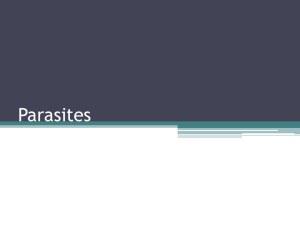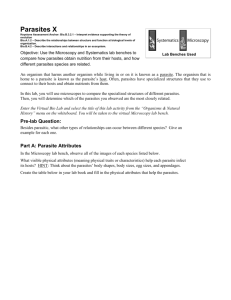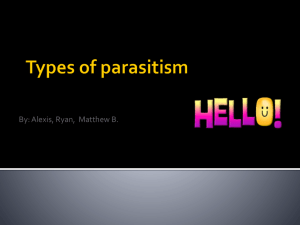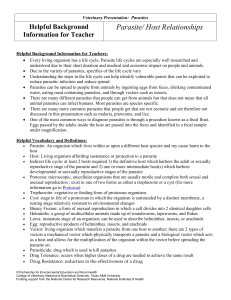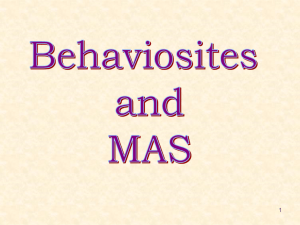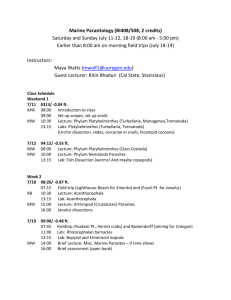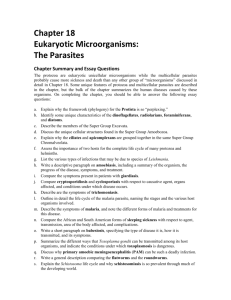Lavigeria nasssa multivariate morphometric approach
advertisement
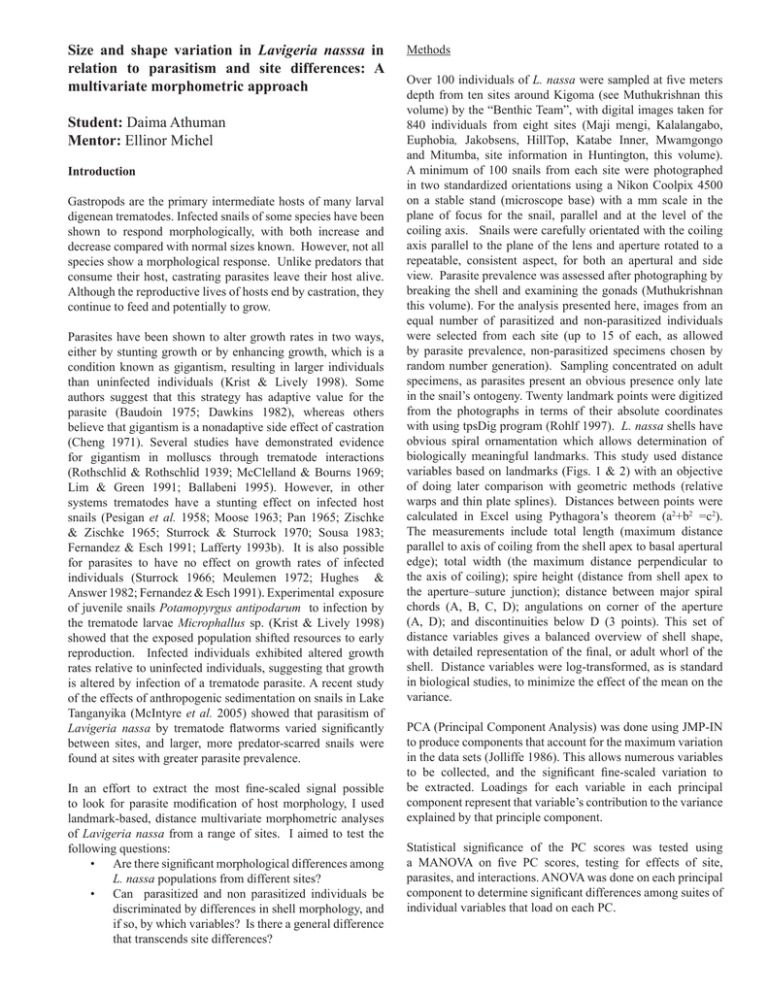
Size and shape variation in Lavigeria nasssa in relation to parasitism and site differences: A multivariate morphometric approach Student: Daima Athuman Mentor: Ellinor Michel Introduction Gastropods are the primary intermediate hosts of many larval digenean trematodes. Infected snails of some species have been shown to respond morphologically, with both increase and decrease compared with normal sizes known. However, not all species show a morphological response. Unlike predators that consume their host, castrating parasites leave their host alive. Although the reproductive lives of hosts end by castration, they continue to feed and potentially to grow. Parasites have been shown to alter growth rates in two ways, either by stunting growth or by enhancing growth, which is a condition known as gigantism, resulting in larger individuals than uninfected individuals (Krist & Lively 1998). Some authors suggest that this strategy has adaptive value for the parasite (Baudoin 1975; Dawkins 1982), whereas others believe that gigantism is a nonadaptive side effect of castration (Cheng 1971). Several studies have demonstrated evidence for gigantism in molluscs through trematode interactions (Rothschlid & Rothschlid 1939; McClelland & Bourns 1969; Lim & Green 1991; Ballabeni 1995). However, in other systems trematodes have a stunting effect on infected host snails (Pesigan et al. 1958; Moose 1963; Pan 1965; Zischke & Zischke 1965; Sturrock & Sturrock 1970; Sousa 1983; Fernandez & Esch 1991; Lafferty 1993b). It is also possible for parasites to have no effect on growth rates of infected individuals (Sturrock 1966; Meulemen 1972; Hughes & Answer 1982; Fernandez & Esch 1991). Experimental exposure of juvenile snails Potamopyrgus antipodarum to infection by the trematode larvae Microphallus sp. (Krist & Lively 1998) showed that the exposed population shifted resources to early reproduction. Infected individuals exhibited altered growth rates relative to uninfected individuals, suggesting that growth is altered by infection of a trematode parasite. A recent study of the effects of anthropogenic sedimentation on snails in Lake Tanganyika (McIntyre et al. 2005) showed that parasitism of Lavigeria nassa by trematode flatworms varied significantly between sites, and larger, more predator-scarred snails were found at sites with greater parasite prevalence. In an effort to extract the most fine-scaled signal possible to look for parasite modification of host morphology, I used landmark-based, distance multivariate morphometric analyses of Lavigeria nassa from a range of sites. I aimed to test the following questions: • Are there significant morphological differences among L. nassa populations from different sites? • Can parasitized and non parasitized individuals be discriminated by differences in shell morphology, and if so, by which variables? Is there a general difference that transcends site differences? Methods Over 100 individuals of L. nassa were sampled at five meters depth from ten sites around Kigoma (see Muthukrishnan this volume) by the “Benthic Team”, with digital images taken for 840 individuals from eight sites (Maji mengi, Kalalangabo, Euphobia, Jakobsens, HillTop, Katabe Inner, Mwamgongo and Mitumba, site information in Huntington, this volume). A minimum of 100 snails from each site were photographed in two standardized orientations using a Nikon Coolpix 4500 on a stable stand (microscope base) with a mm scale in the plane of focus for the snail, parallel and at the level of the coiling axis. Snails were carefully orientated with the coiling axis parallel to the plane of the lens and aperture rotated to a repeatable, consistent aspect, for both an apertural and side view. Parasite prevalence was assessed after photographing by breaking the shell and examining the gonads (Muthukrishnan this volume). For the analysis presented here, images from an equal number of parasitized and non-parasitized individuals were selected from each site (up to 15 of each, as allowed by parasite prevalence, non-parasitized specimens chosen by random number generation). Sampling concentrated on adult specimens, as parasites present an obvious presence only late in the snail’s ontogeny. Twenty landmark points were digitized from the photographs in terms of their absolute coordinates with using tpsDig program (Rohlf 1997). L. nassa shells have obvious spiral ornamentation which allows determination of biologically meaningful landmarks. This study used distance variables based on landmarks (Figs. 1 & 2) with an objective of doing later comparison with geometric methods (relative warps and thin plate splines). Distances between points were calculated in Excel using Pythagora’s theorem (a2+b2 =c2). The measurements include total length (maximum distance parallel to axis of coiling from the shell apex to basal apertural edge); total width (the maximum distance perpendicular to the axis of coiling); spire height (distance from shell apex to the aperture–suture junction); distance between major spiral chords (A, B, C, D); angulations on corner of the aperture (A, D); and discontinuities below D (3 points). This set of distance variables gives a balanced overview of shell shape, with detailed representation of the final, or adult whorl of the shell. Distance variables were log-transformed, as is standard in biological studies, to minimize the effect of the mean on the variance. PCA (Principal Component Analysis) was done using JMP-IN to produce components that account for the maximum variation in the data sets (Jolliffe 1986). This allows numerous variables to be collected, and the significant fine-scaled variation to be extracted. Loadings for each variable in each principal component represent that variable’s contribution to the variance explained by that principle component. Statistical significance of the PC scores was tested using a MANOVA on five PC scores, testing for effects of site, parasites, and interactions. ANOVA was done on each principal component to determine significant differences among suites of individual variables that load on each PC. Figure 1: Landmark locations on an L. nassa showing placement on homologous points associated with the protoconch (LM 1) sutures (LM 2,3, 8, 15, 20) major cords (LM 4, 5, 6, 7, 9, 10, 15, 16, 17) basal cords (LM 12, 13, 14). LM 11 is estimated as the bottom edge of the coiling axis, with homology more difficult to determine Results I retained the first five PCs with variance and variable weights indicated in Table 1. As is common in morphological studies, PC1 was a size axis (consistently positive loadings among all variables). The graphical results from the PCA revealed no obvious differences between parasitized and non-parasitized individuals. Plots of PCs 1-4 indicated individual scores were all scattered along the principal component axis uniformly. There was no evident clustering by site or parasite status. MANOVA indicated a highly significant site effect on morphology (<0.0001, Table 2) but no significant effect of parasites, even in interaction with site. The ANOVAs on individual PC scores consistently indicated site effects (across all examined PCs) and a few effects of parasites (Table 3). PC1 showed a significant site effect (p < 0.0001) and none in parasite or in parasite-site interaction (p < 0.4137; p < 0.493 respectively). The PC2 shows significant differences in parasitized and non-parasitized individuals (p < 0.0416) and also based on site (p < 0.0001) but not on parasite-site interactions (p < 0.7352). In PC3 loadings there was no significant parasite effect (p < 0.6727) but there was a significant effect on parasite-site interactions (<0.0069) and on each site (<0.0002). Loadings on PC4 and PC5 have significant site effects (p < 0.0204; p < 0.0005) but no parasite effects either directly or when nested within site. Discussion The loadings that may correlate with parasite effect on PC2 might be distance from 4-5, which is cord A and B, and also 17-18 which is also the same distance on the other side (see image 2 for the distance and table 1 for the loadings). Other distances are 7-8 and 8-9 which are distances from cord D to the suture and cord A on the aperture to cord D on the aperture Figure 2: Distance variables obtained from the landmarks edge respectively. The loading is also contributed to by distance 11-18, which is the shell width. The results makes sense given the fact that the distance associated with the loadings are from the body area where the gonads are located, and therefore it is possible that the parasite caused alteration of shape in that part of the shell. Generally, my results do not show any variation in shell size between parasitized and non-parasitized individuals but they suggest that there is significant morphometric variation within site as shown by the results of ANOVA on PC1. Reviews of results of previous studies on host-parasite response include that of Krist & Lively (1998) which shows that Microphallus causes stunting in P. antipodarum and no evidence of gigantism. These results are consistent with Ruiz’s (1990) study on host evolution that incidence of trematodes parasites may explain reduced size. Another study on the relationship between size and parasitism in P. antipodarum seems inconsistent with these results that parasitized snails are smaller than unparasitized snails (as cited by Krist & Lively 1998), Jokela & Lively (1995a) found that the probability of infection by Microphallus increases with length of snails from a field population. A study of temporal variation in parasite loadings in relation to life histories patterns of Littorina obtusata and Littorina fabalis (Williams & Brailsford 1998) shows that parasitic infection altered the morphology of both species, though changes in shell morphology were variable. The scientific literature indicates that there can be significant changes in host morphology when parasites are present, with the implication that this is a life history response of value either to the host, or (more likely) the parasite. My study included balanced sample design, detailed data collection, and numerous study sites to control for local variation, yet the results clearly indicated only minor morphological changes in the gastropods in correlation with parasites. Clearly this system has evolved a different response mechanism than many others outlined in the literature. Conclusion and Future Research The initial goal of this project was to determine whether presence of parasites leaves a morphological signal on the shell of the gastropod host, but the photographic and morphometric data set I produced for Lavigeria nassa may be used to test other hypothesis including the morphological variation among populations at different sites, changes in developmental programs (allometry) and fine-scale effects of predation on shell morphology. Many of the specimens imaged were saved for genetic work and the photographic record can be used to back-trace the known genetic diversity in L. nassa populations (Kuh et al. 2004) to their associated morphological signal. Acknowledgements I wish to thanks my mentor Ellinor Michel for her tolerant and motherly supervision and for introducing me to intriguing, lovely and the wonderful gastropods of Lake Tanganyika, this will forever be cherished. My sincere thanks goes to benthic team member Ranjan Muthkrishnan for all the sampling he did for me and his parasite data that allows this project to be possible. Also I would like to thank Winston Wheeler for helping me on complicated mathematical part of this project. Lastly, thanks to all Nyanza team 2004 crew, especially Bigeyo Kuboja, Sherry-Ann Todd Pearson, Huruma, Brittney H. and Happy for their company at Nyanza and helping me on the time limiting part of my project, scrubbing snails. References Albrecht, G. H., 1980. Multivariate analysis and the study of form, with special reference to cananonical variate analysis. Amer. Zool. 20: 679-693. Ballabeni P (1995) Parasite induced gigantism in a snail: a host adaptation? Funct Ecol 9:887-893 Baudoin M(1975) Host castration as a parasitic strategy. Evolution 29:335-352 Cheng TC (1971) Enhanced growth as a manifestation of parasite and shell deposition in parasitism mollusks. In: Cheng TC(ed) Aspects of the biology of symbiosis. University Park Press. Baltimore, pp 103-137 Chiu, Y., H. Chen, S. Lee, and C. A. Chen. 2002. Morphometric analysis of shell and operculum variations in the viviparid snail, Cipangopaludina chinensis (Mollusca: Gastropoda), in Taiwan. Zoological studies 41(3): 321-331. Dawkins R (1982) The extended phenotype . Oxford University Press , Oxford. Fernandez J, Esch GW (1991) Effect of parasitism on the growth rate of pulmonate snail Helisoma anceps. J. Parasitol77;937-944 Hughes RN, Answer P (1982) Growth, spawning and trematode infection of Littorina littorea (L) from an exposed shore in North Wales. J Moll Stud 48: 321-330 Katoh, M and D.W.Foltz 1994. Genetic subdivision and morphological variation in a freshwater snail specie complex formerly referred to as Viviparus georgianus (Lea). Biol. J. Linn .Soc. Lond. 53: 73-90. Krist AC, Lively CM (1998) Experimental exposure of juvenile snails potamopyrgus antipodarum to infection by trematode larvae Microphallus sp. Infectivity, fecundity compensation and growth Lafferty KD (1993b) Effectsof parasite castration on growth, reproduction and population dynamics of the marine snail Cerithidea californica. Mar Ecol Prog Ser 96:229-237 McClelland GT, Bourns KR (1969) Effects of Trichobilharzia ocellataon growth, reproduction and survival of Lymnaea stagnalis. Exp Parasitol 24: 137-146 Meuleman EA (1972) Host parasite interrelationships between the freshwater pulmonate Biomphalaria pfeifferi and the trematode Schistosoma mansoni. Neth J Zool 22: 355-427 PAST citation –http://folk .uio.no/ohammer/past/ Pesigan TP, Hairston NG, Jauregui JJ, Garcia EG, Santos BC Besa AA (1958) studies on Schistosoma japonicum infection in the philllipines . 2 . The molluscan d host. Bull World Health Org. 18:481578 Rothschlid A , Rothschlid M (1939) Some observation on the growth of P[eringia alvae (Pennant) 1777 in the laboratory, Nov. Zool. 51:240-247 Ruiz GM (1990) Host evolution? Symposium on New perspectives in soft sediment Ecology presented at the Annual meeting of the A MERICAN SOCIETY OF zoologists, 831-838 Sturrock BM, Sturrock RF (1970) laboratory studies of the host parasite relationship of Schistosoma mansoni and Biomphalaria glabrata after from st. Lucia, West Indies . Ann Trop Med Parasitol 64: 357—363 Wagner, Catherine (2004). ( title )B.Sc. honors thesis, Whitman college, WA, USA 35pp Zische JA Zische DP (1965) The effects of Echinostoma revolutum larval infection on the growth and the reproduction of the snail Stagnicola palustris .Am Zool 5-707-708 Eigenvectors % var explained> PC1 (size) 49.3% 1_11 10_15width 2_20 3_19 7_15 1_2 1_20 2_3 19_20 3_4 18_19 4_5 17_18 5_6 16_17 6_7 15_16 3_7 15_19 7_8 8_9 9_10 10_11 11_18 11_12 12_13 13_14 0.26135 0.22782 0.23346 0.25585 0.25337 0.21473 0.22541 0.21072 0.21242 0.12528 0.12710 0.15979 0.10097 0.16447 0.12519 0.14522 0.14171 0.24854 0.23653 0.10333 0.14337 0.17749 0.19437 0.24715 0.18018 0.11493 0.13105 PC2 6.3% -0.00853 -0.15077 0.05772 0.03094 -0.10716 0.14772 0.09417 0.06009 0.14864 -0.05978 0.08923 -0.30379 -0.45552 0.02085 0.11825 0.31109 0.00197 0.00487 -0.15802 0.45985 0.32202 -0.05184 -0.27244 -0.10107 -0.08119 0.20688 -0.07408 PC3 4.8% -0.07109 0.08770 -0.22549 -0.04914 0.00477 -0.29304 -0.28219 0.06786 0.06646 0.04293 0.02124 0.15318 0.22133 -0.20943 -0.36414 0.16572 0.41534 0.04741 0.12301 0.26617 0.31458 -0.05061 0.01641 0.00447 0.01765 0.17206 0.05751 PC4 4.6% -0.00526 -0.05768 0.08596 0.04787 -0.02826 0.11888 0.08029 -0.03741 0.00667 -0.39788 -0.48586 0.33232 0.35794 -0.16506 -0.02754 0.04502 -0.16506 -0.00925 -0.04347 0.31497 0.08800 0.10751 -0.12006 -0.02254 -0.18916 0.00118 -0.04829 Table 1: Eigenvectors for each morphometric variable – shaded indicates emphasis Whole Model: F Test Site: F Test Parasites Value Exact F NumDF DenDF Prob>F 0.4437616 4.9997 15 169 <.0001 0.3859211 9.3172 7 169 <.0001 F Test Para*Site 0.0020265 0.3425 1 169 0.5592 F Test 0.0577728 1.3948 7 169 0.2105 Table 2: MANOVA – all 5 PCs Source PC1: site para para*site PC2: site para site*para PC3: site para site*para PC4: site para site*para PC5: site para site*para DF Sum of Squares F Ratio Prob > F 7 1 7 862.48938 4.57188 68.79000 12.8827 0.4780 1.0275 <.0001 0.4903 0.4137 7 1 7 80.168830 5.741288 5.956607 8.4047 4.2133 0.6245 <.0001 0.0416 0.7352 7 1 7 33.770529 0.200955 22.769301 4.2999 0.1791 2.8992 0.0002 0.6727 0.0069 7 1 7 20.932065 2.299908 7.806533 2.4485 1.8832 0.9132 0.0204 0.1718 0.4977 7 1 7 27.471110 0.278379 9.514097 3.9256 0.2785 1.3596 0.0005 0.5984 0.2256 Table 3: ANOVAs – each PC individually PC5 4.0% -0.11930 0.21000 -0.02235 -0.02620 0.08200 -0.07568 -0.08047 -0.13050 -0.04793 0.24741 0.06967 0.02463 -0.01093 -0.19702 0.26213 0.04130 -0.12216 0.04485 0.08501 0.00949 0.02795 -0.33040 0.30037 -0.15704 -0.48055 0.32629 0.22411
